unit 4 biology
1/83
Earn XP
Description and Tags
Name | Mastery | Learn | Test | Matching | Spaced |
|---|
No study sessions yet.
84 Terms
homeostasis
- the state of relatively stable internal conditions
- organisms detect and respond to a stimulus
- body uses feedback loops to maintain
set points
- values for various physiological conditions that the body tries to maintain
- has a normal range for which it can fluctuate
- ex: body temp set point= 98.6; normal range= 97-99
stimulus
variable that will cause a response (actions)
receptor/sensor
- sensory organs that detect a stimulus
- info sent to brain (organs)
effector
muscle or gland that will respond (organs)
response
changes (decreases or increases) the effect of the stimulus (actions)
negative feedback
- returns/reduces the effect of the stimulus
- most common
- ex: sweat, blood sugar, breathing rate, body temp
negative feedback example
body temp regulation
- stimulus: heat
- receptor: temp receptors in skin
- effector: sweat glands
- response: sweat
positive feedback
- increases the effect of a stimulus
- ex: child labor, blood clotting, fruit ripening, lactation
positive feedback example
childbirth
- stimulus: baby pushes on cervix
- receptor: nerve cells in cervix send signal to brain
- effector: pituitary gland releases oxytocin
- response: oxytocin stimulates contraction
repeats
homeostatic imbalances examples
genetic disorders, drug/alcohol abuse, intolerable conditions
disease
- when the body is unable to maintain homeostasis
- cancer: body can't regulate cell growth
- diabetes: body can't regulate blood glucose levels
cell communication
- occurs through signal transduction pathways
- vital to cell function, survival, and maintaining homeostasis
- responsible for growth and development of multicellular organisms
- communication methods: direct contact, local signaling, long distance signaling
direct contact
- communication through cell junctions
- signaling substances and other material dissolved in the cytoplasm can pass freely between adjacent cells
- animal cells= gap junctions
- plant cells= plasmodesmata
- ex: immune cells (antigen presenting cells communicate to T cells)
local regulators
- a secreting cell will release chemical messages (local regulators/ligands) that travel a short distance through the extracellular fluid
- chemical messages will cause a response in a target cell
- paracrine and synaptic signaling
paracine signaling
secretory cells release local regulators (ex: growth factors, the start of mitosis) via exocytosis to an adjacent cell
synaptic signaling
- occurs in animal nervous system
- neurons secrete neurotransmitters
- diffuse across synaptic cleft (space between nerve and target cell)
long distance signaling
- animals and plants use hormones
- plants release hormones that travel in the plant vascular tissue (xylem, pholem) or through the air to reach target tissues
- animals use endocrine signaling: specialized cells release hormones into circulatory system where they reach target cells
- ex: insulin released by the pancreas into bloodstream where it circulates through body and binds to target cells (animals)
cell signaling
1. reception: ligand binds to receptor
2. transduction: signal is converted
3. response: a cell process is altered
reception
- the detection and receiving of a ligand by a receptor in the target cell
- when ligand binds to receptor, receptor activates via a conformational change. this allows receptors to interact with other cellular molecules, initiating the transduction signal
- receptors can be in plasma membrane or intracellular
receptor
- macromolecule that binds to a signal molecule (ligand)
- all have an area that interacts with the ligand and an area that transmits a signal to another protein
- binding between ligand and receptor is highly specific
plasma membrane receptors
- most common type of receptor involved in signal pathways
- binds to polar, large, water-soluble ligands
- ex: G protein coupled receptors, ligand-gated ion channels
intracellular receptors
- found in cytoplasm or nucleus of target cell
- binds to ligands that can pass through the plasma membrane
- ex: hydrophobic molecules (steroid and thyroid hormones, gases like nitric oxide)
transduction
- the conversion of an extracellular signal to an intracellular signal that will bring about a cellular response
- requires a sequence of changes in a series of molecules known as a signal transduction pathway
- the signal transduction pathway regulates protein activity through phosphorylation and dephosphorylation
- signal is amplified
kinase
- turns signal on
- phosphorylates
- enzyme protein
phosphatase
- turns signal off
- dephosphorylates
- enzyme protein
second messengers
- small, nonprotein molecules and ions help relay the message and amplify the response
- ex: cyclic AMP
response
- the final molecule in the signaling pathway converts the signal to a response that will alter a cellular process
- ex: protein that can alter membrane permeability, enzyme that will change a metabolic process, protein that turns genes on/off
signal transduction pathways
- can influence how a cell responds to its environment
- can result in changes in gene expression, cell function, phenotypes, or cell death
- mutations to receptor proteins or to any component of the signaling pathway will result in a change to the transduction of the signal
cell membrane receptors
- G protein coupled receptors
- ion channels (ligand gated)
G protein coupled receptors
- largest category of cell surface receptors
- important in animal sensory systems
- binds to a G protein that can bind to GTP
- GPCR, enzyme, and G protein inactive until ligand binds to GPCR on extracellular side
- ligand binding causes cytoplasmic side to change shape, allowing G protein to bind to GPCR and activating the GPCR and G protein, GDP becomes GTP
- part of activated G protein can bind to enzyme, activating enzyme and amplifying signal and leads to a cellular response
GTP
energy molecule that can phosphorylate like ATP
ion channels (ligand gated)
- located in plasma membrane
- important in nervous system
- receptors that act as a "gate" for ions
- when a ligand binds to the receptor, the "gate" opens/closes allowing the diffusion of specific ions
- initiates a series of events that lead to a cellular response
cell cycle
the life of a cell from its formation until it divides
cell division
allows for the reproduction of cells, growth of cells, and tissue repair
what cells do before division
organize and package their DNA
nucleosomes
formed when DNA associates with and wraps around proteins (histones)
chromatin
- strings of nucleosomes
- in a non-condensed form when cell is not actively dividing
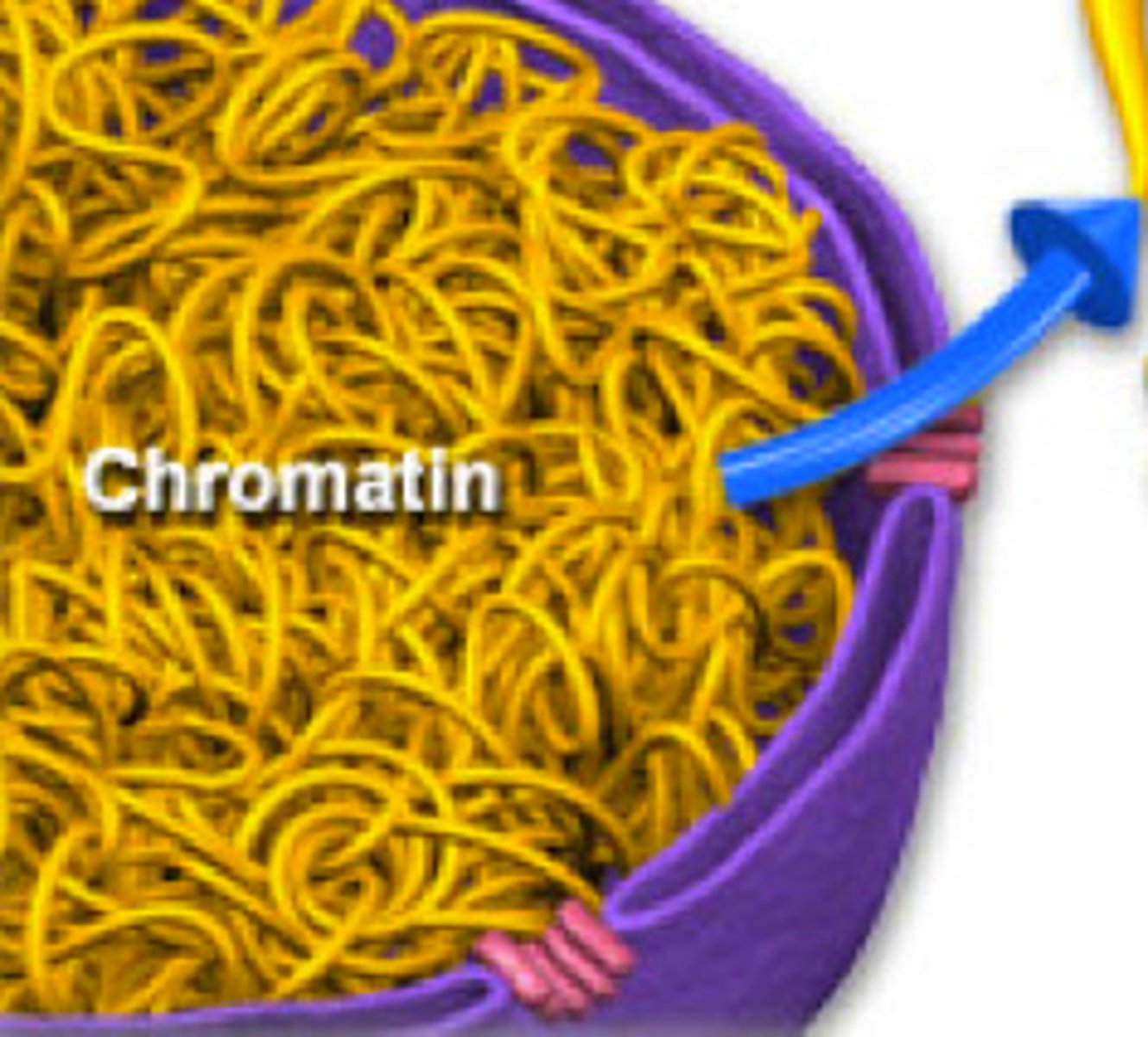
chromosome
- formed when chromatin condenses after DNA replication
- densely packed to allow for easier division
- too elongated -> risks not being replicated and duplicated correctly
- each has a duplicated copy since DNA is replicated
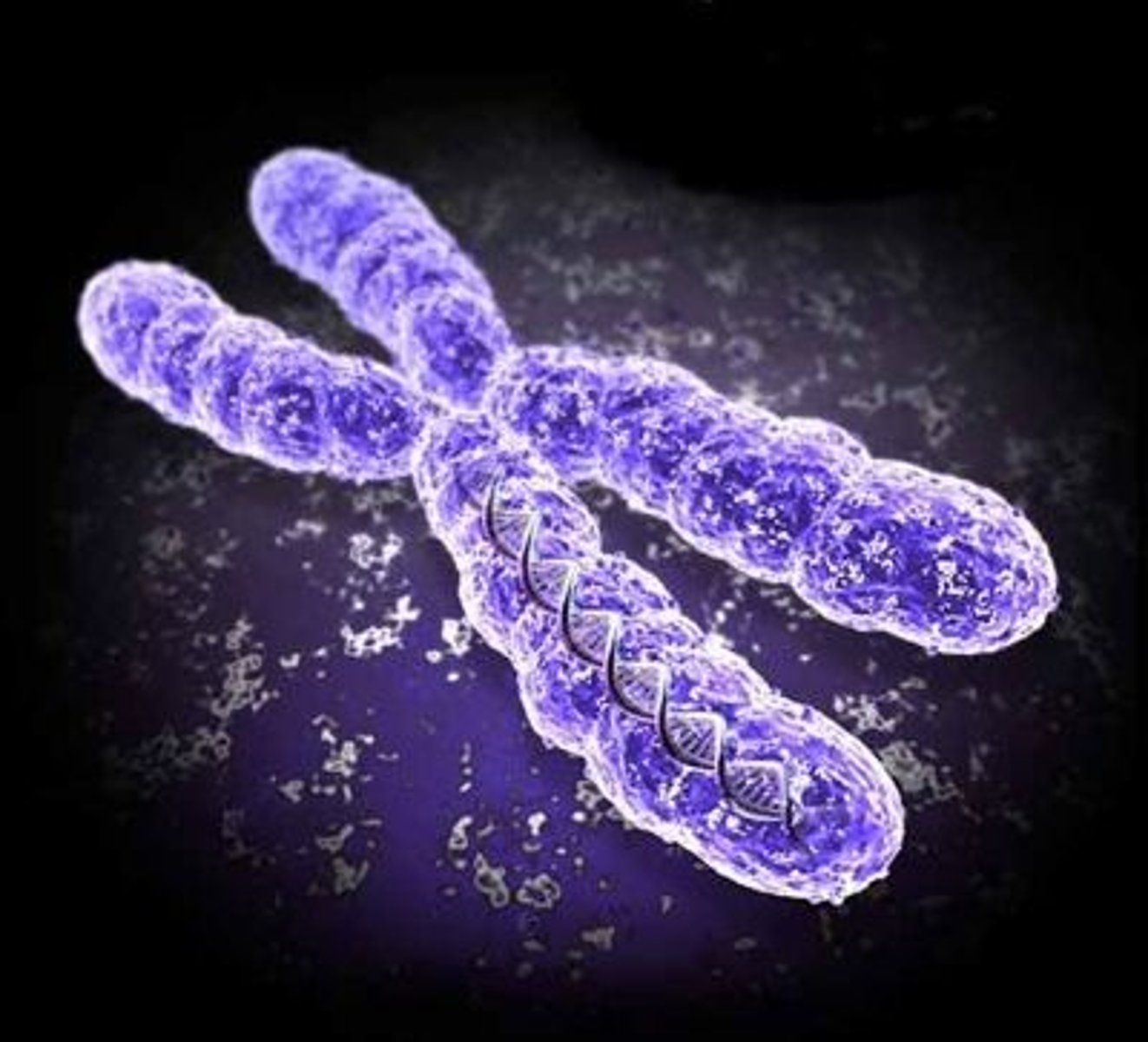
sister chromatids
copies of chromosomes joint together
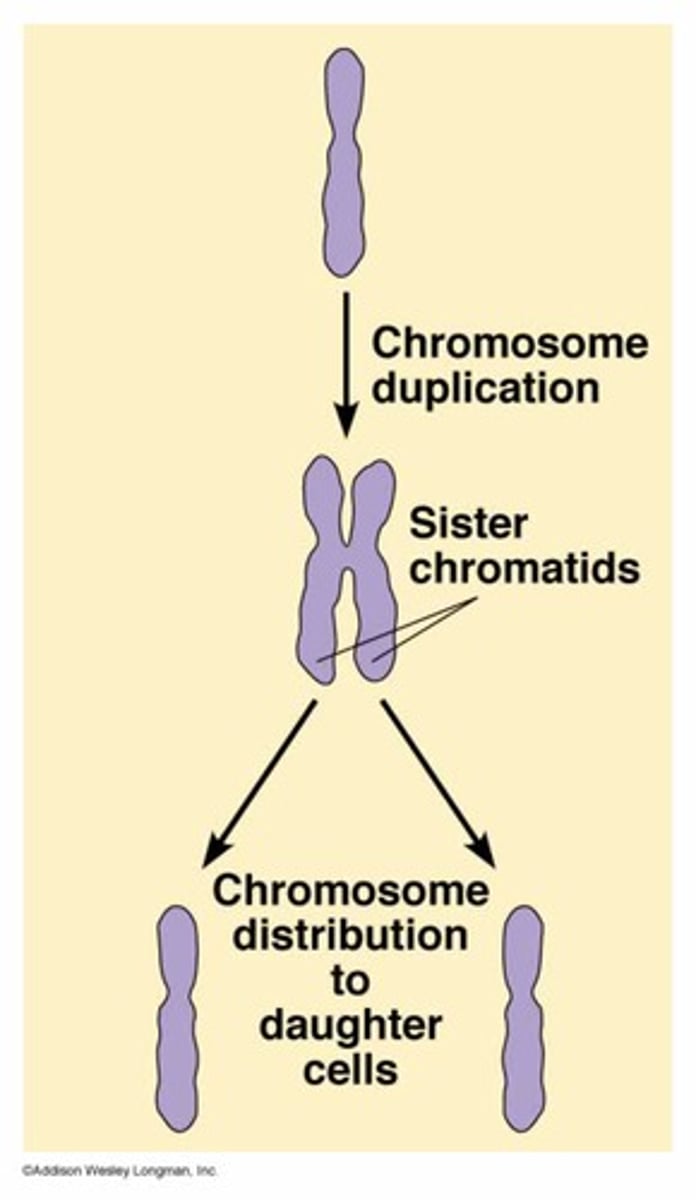
centromere
the region on each sister chromatid where they are most closely attached
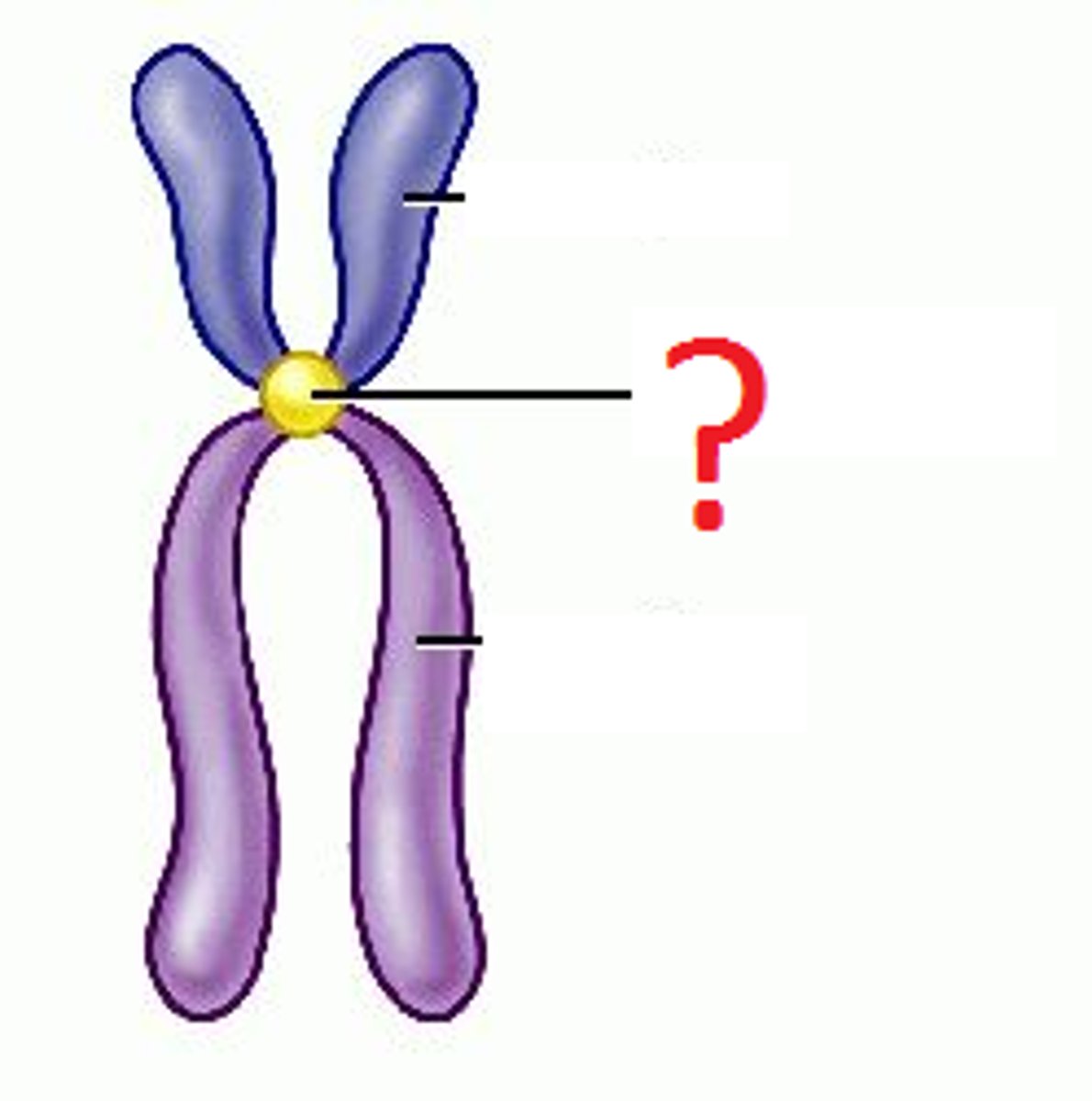
kinetochore
proteins attached to the centromere that link each sister chromatid to the mitotic spindle
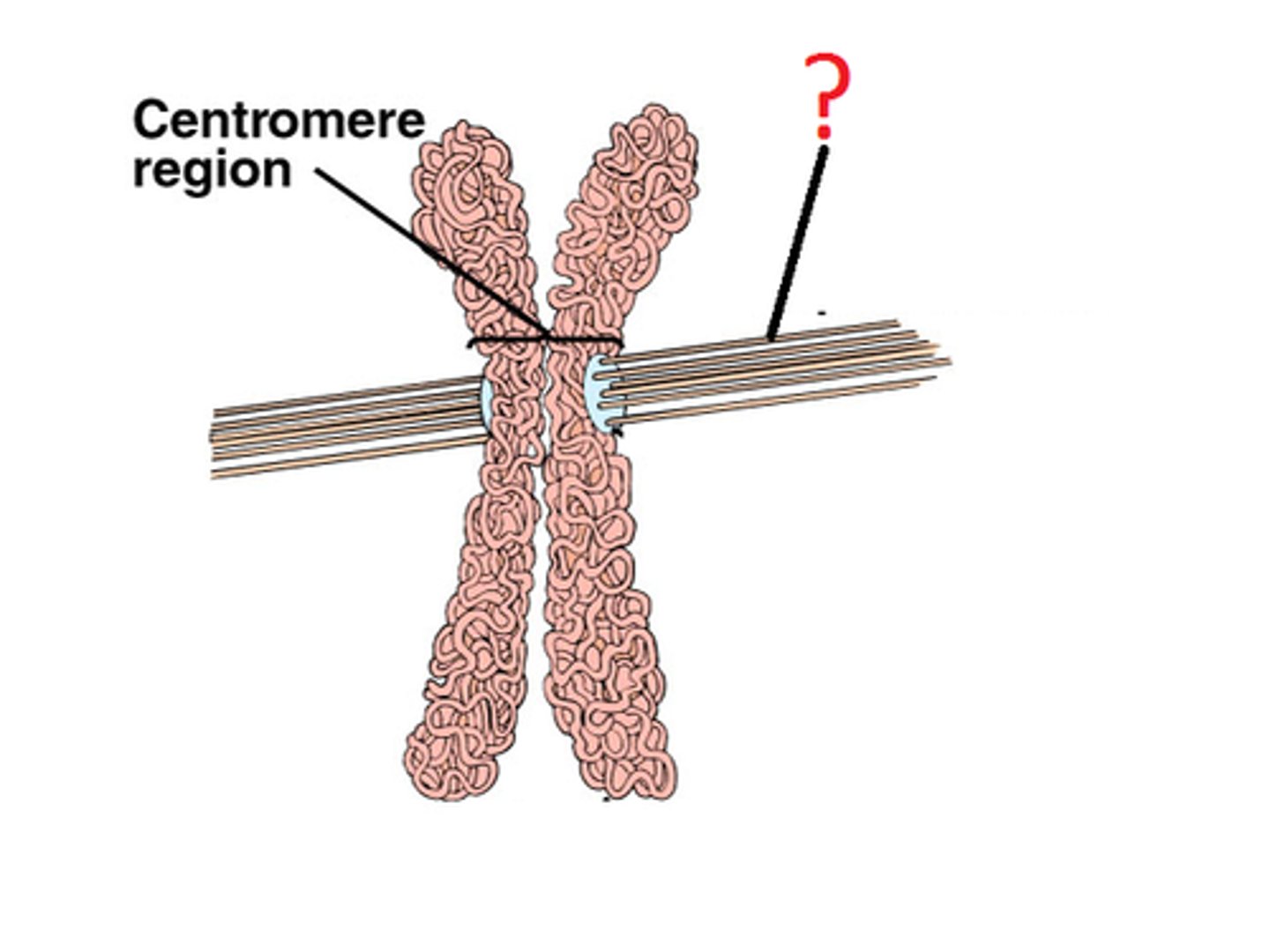
genome
all of a cell's genetic information (DNA)
prokaryotes
singular, circular DNA
eukaryotes
- one or more linear chromosomes
- has a specific number of chromosomes
- ex: humans have 46 chromosomes
homologous chromosomes
two chromosomes (one from each parent) that are the same length, have the same centromere position, and carry genes controlling the same characteristics
somatic cells
- body cells
- diploid
- divide by mitosis
- ex: humans -> 2n=46
gametes
- reproductive cells (sex, sperm)
- haploid
- divide by meiosis
- ex: humans -> n=23
diploid
- 2n
- two sets of chromosomes (one from each parent)
haploid
- n
- one set of chromosomes
cell cycle
- consists of alternating phases of interphase and mitosis
- G1 -> S -> G2 (interphase) -> mitosis -> cytokinesis
interphase
- longest portion of the cell cycle (90%)
- G1 "first gap" phase
- S "synthesis" phase
- G2 "second gap" phase
G1 "first gap" phase
cell grows and carries out normal functions
S "synthesis" phase
DNA replication and chromosome duplication occurs
G2 "second gap" phase
final growth and preparation for mitosis
M phase
- mitosis: nucleus divides
- cytokinesis: cytoplasm divides
- mitosis results in 2 identical diploid daughter cells
phases of mitosis
1. prophase
2. prometaphase
3. metaphase
4. anaphase
5. telophase and cytokinesis
prophase
- chromatin condenses
- nucleoli disappear
- duplicated chromosomes appear as sister chromatids
- mitotic spindle begins to form
- centrosomes move away from each other
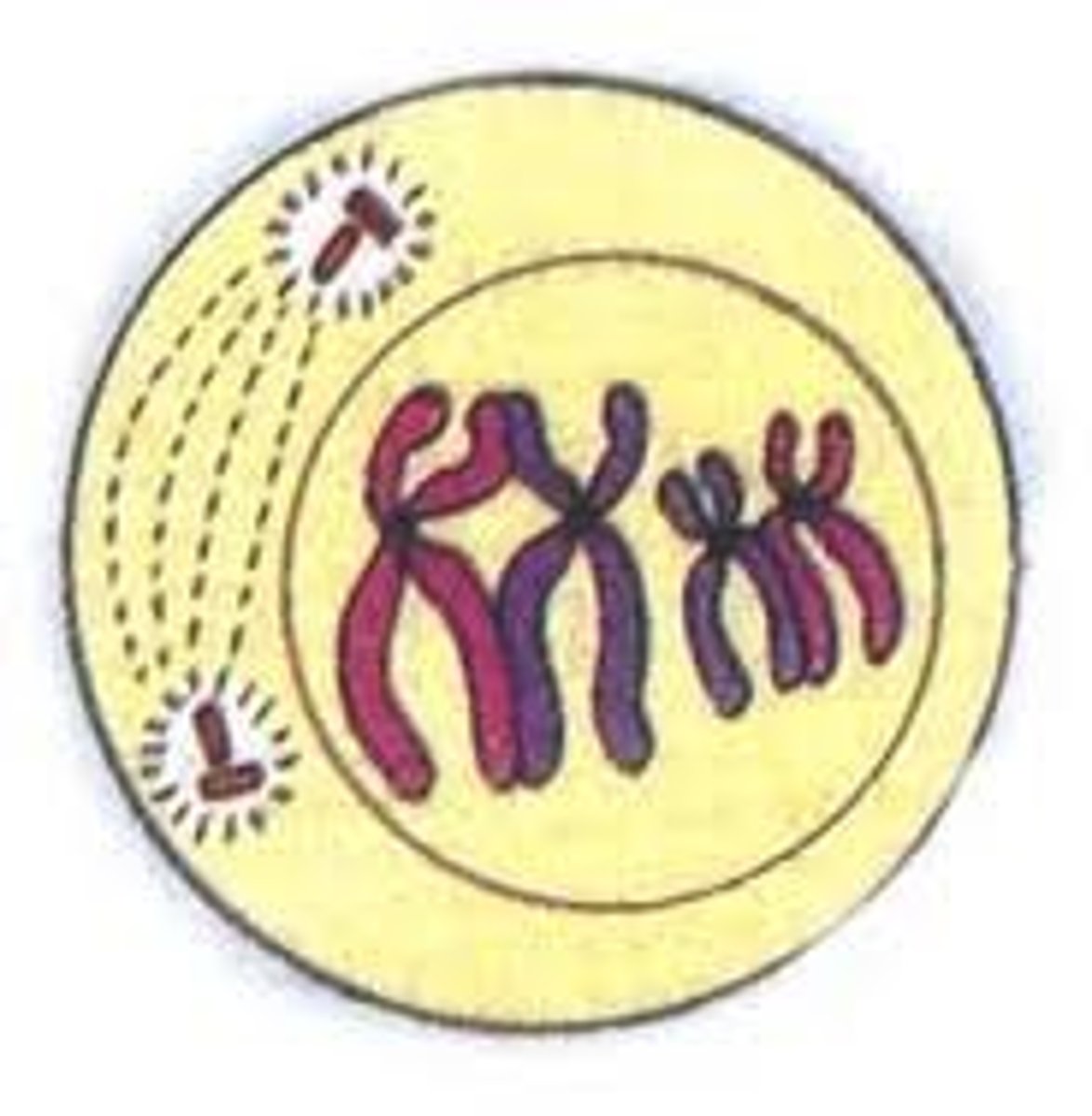
prometaphase
- nuclear envelope fragments
- microtubules enter nuclear area and some attach to kinetochores (center)
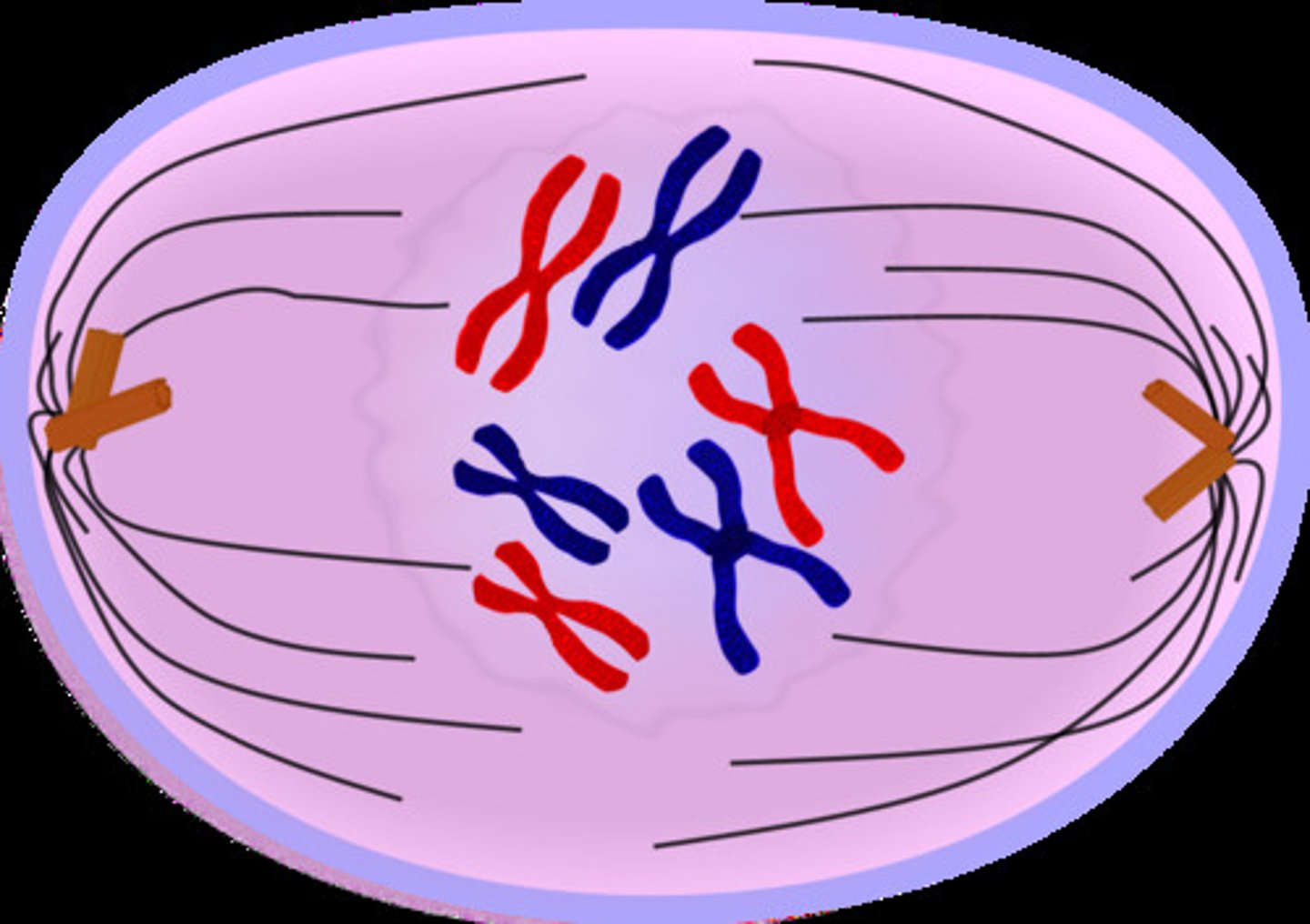
metaphase
- centrosomes are at opposite poles
- chromosomes line up at the metaphase plate
- microtubules are attached to each kinetochore
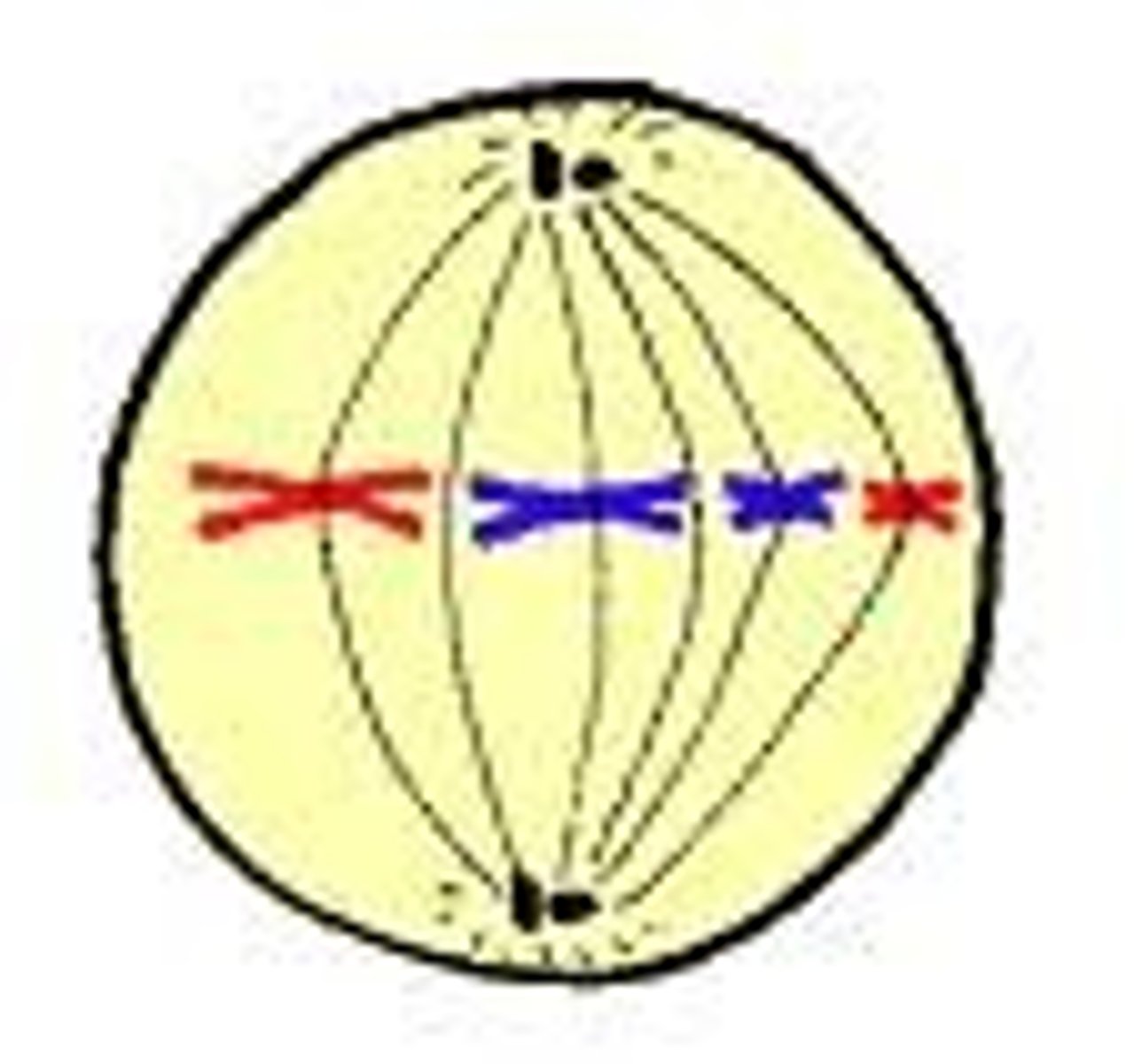
anaphase
- sister chromatids separate and move to opposite ends of the cell due to the microtubules shortening
- cell elongates
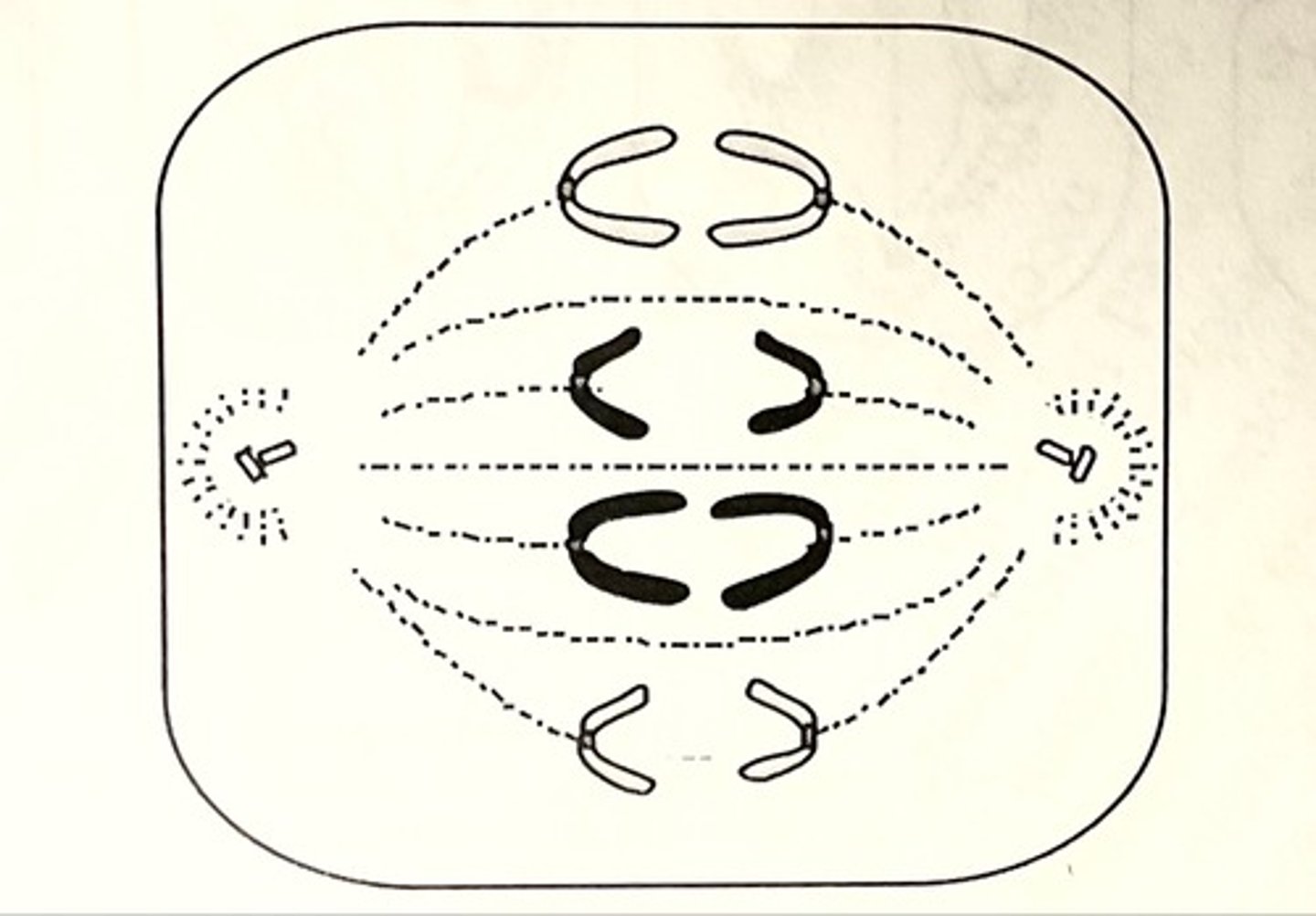
telophase and cytokinesis
- two daughter nuclei form
- nucleoli reappear
- chromosomes become less condensed
- cytokinesis occurs
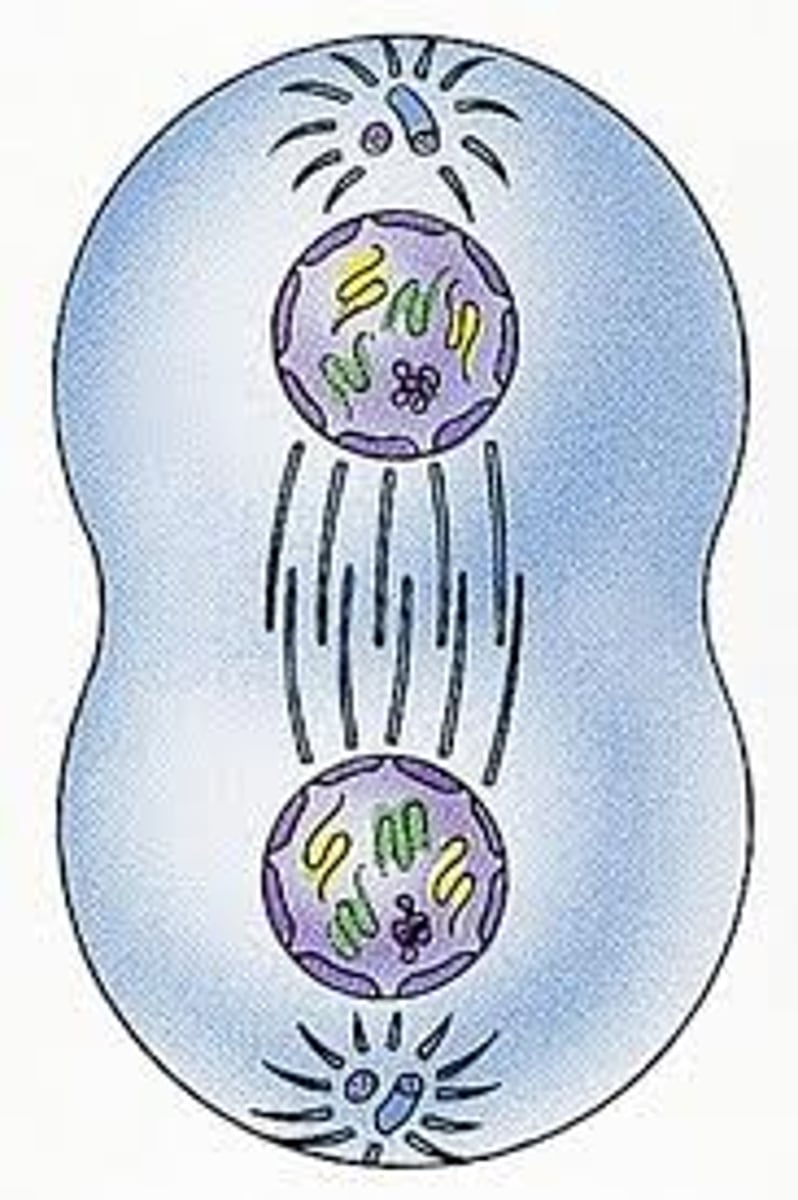
cytokinesis
- animals: cleavage furrow appears due to a contractile ring of actin filaments
- plants: vesicles produced by the golgi travel to the middle of the cell and form a cell plate
tracking chromosomes
- parent cell: 2n=2; 2 chromosomes
- daughter cells: 2n=2; 2 chromosomes
- after S phase: 2 chromosomes, 4 chromatids
- anaphase: 4 chromosomes
- humans: 46 chromosomes, 46 chromatids
checkpoints
- control points that regulate the cell cycle
- cells receive stop/go signals
- G1, G2, M
G1 checkpoint
- checks for cell size, growth factors, and DNA damage
- most important checkpoint
- GO: cell completes whole cell cycle
- STOP: cell enters a non-dividing state (G0)
G0 phase
- some cells (muscle/nerve) stay here forever
- some cells can go back into the cell cycle
G2 checkpoint
- checks for completion of DNA replication and DNA damage
- GO: cell proceeds to mitosis
- STOP: cell cycle stops, cell attempts to repair damage. if damage cannot be repaired, the cell will undergo apoptosis
apoptosis
programmed cell death
M (spindle) checkpoint
- checks for microtubule attachment to chromosomes at the kinetochores at metaphase
- GO: cell proceeds to anaphase and completes mitosis
- STOP: cell will pause mitosis to allow for spindles to finish attaching to chromosomes
cyclins and cyclin-dependent kinases
regulation of the cell cycle involves an internal control system
cyclin
- protein
- concentration varies
- synthesized and degraded at specific stages of the cell cycle
cyclin-dependent kinases
- enzymes
- concentration remains constant
- active only when its specific cyclin is present
- for full activation, many CDKS require phosphorylation by a cyclin-activating kinase
- each has a specific regulatory effect
- active CDK complexes phosphorylate target proteins, helping regulating key events in the cell cycle
growth factors
- hormones released by cells that stimulate cell growth
- signal transduction pathway is initiated
- CDKs are activated leading to progression through the cell cycle
contact (or density) inhibition
- cell surface receptors recognize contact with other cells
- initiates signal transduction pathway that stops the cell cycle in G1 phase
anchorage dependence
cell rely on attachment to other cells or the extracellular matrix to divide
DNA mutations
how normal cells become cancerous
normal cells
- follow checkpoints
- divide 20-50 times in culture
- significant errors -> apoptosis
cancer cells
- don't follow checkpoints
- divide infinitely in culture
- "immortal"
- escape apoptosis and continue to divide with errors
tumor
- mass of tissue formed by abnormal cells
- can be caused by uncontrollable growth of cancer cells
- types: benign and malignant
benign tumor
- cells abnormal but not cancerous yet
- cells remain at tumor site and unable to spread throughout body
malignant tumor
mass of cancerous cells that lose their anchorage dependency and can leave the tumor site
metastasis
when cells separate from the tumor and spread elsewhere in the body
cancer prevention
- don't smoke: nicotine causes mutations at high rates
- eat healthy and drink water: fatty foods and dehydration can affect cell function
- protect skin from sun: sun damages skin cells and can cause mutations